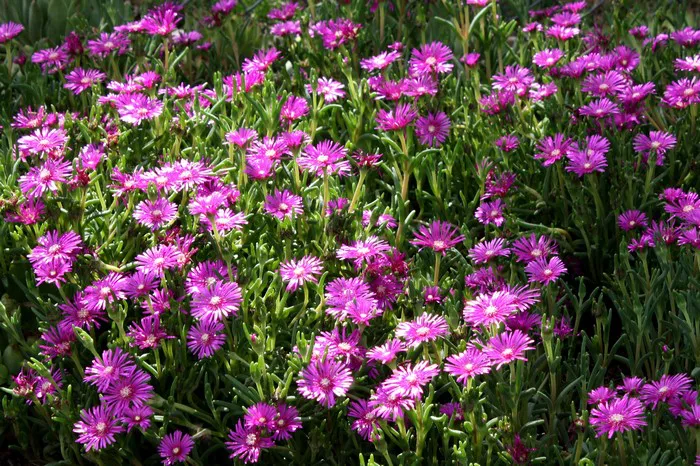Ice plants (Delosperma spp.) are a delightful addition to any succulent garden, with their vibrant flowers and low-maintenance requirements. These hardy plants are native to South Africa and thrive in dry, sunny conditions, making them perfect for xeriscaping projects and rock gardens. Propagating ice plants is a rewarding endeavor that allows you to expand your collection or share these beauties with friends and family. In this comprehensive guide, we’ll explore various propagation techniques for ice plant succulents, from seed sowing to division and stem cuttings.
Understanding Ice Plant Propagation
Before diving into propagation methods, it’s essential to understand the basic biology of ice plants. These succulents reproduce both sexually and vegetatively, offering multiple avenues for propagation. Sexual reproduction occurs through seeds, while vegetative reproduction involves producing new plants from existing plant parts such as stems, leaves, or offsets.
Ice plants are known for their ability to produce offsets, also known as pups or plantlets, around the base of the mother plant. These offsets can be carefully separated and replanted to grow into new plants. Additionally, ice plants can be propagated from stem cuttings, which root readily under the right conditions. Understanding these natural processes is key to successful propagation.
Propagation Methods
1. Propagation from Seeds:
Propagating ice plants from seeds is a straightforward process that mimics their natural reproductive cycle. Follow these steps for successful seed propagation:
Seed Collection: Wait until the flowers have dried and formed seed pods. Harvest the pods and allow them to dry completely before extracting the seeds.
Seed Preparation: Gently crush the seed pods to release the small, black seeds. Remove any debris or chaff, and store the seeds in a dry, cool place until ready for sowing.
Sowing Seeds: Fill a shallow tray or seedling flats with a well-draining potting mix. Sprinkle the ice plant seeds evenly over the surface of the soil and lightly press them into the soil.
Moisture and Light: Mist the soil surface with water to moisten it, and place the tray in a bright, sunny location. Avoid direct sunlight, as it can scorch the delicate seedlings. Keep the soil consistently moist but not waterlogged.
Transplanting: Once the seedlings have developed several sets of true leaves and are large enough to handle, transplant them into individual pots filled with a well-draining succulent mix.
2. Propagation from Offsets:
Propagating ice plants from offsets is one of the easiest and most reliable methods. Follow these steps to propagate from offsets:
Offset Identification: Identify healthy offsets growing around the base of the mother plant. These offsets should have developed their own root systems.
Separation: Carefully dig around the base of the mother plant to expose the offsets’ roots. Gently separate the offsets from the main plant using a sharp, sterile knife or scissors.
Rooting: Plant the offsets in a well-draining succulent mix, pressing the soil gently around the roots. Water lightly to settle the soil and encourage root growth.
Establishment: Place the newly potted offsets in a bright, sunny location with indirect sunlight. Allow the soil to dry slightly between waterings to prevent root rot.
Maintenance: Keep an eye on the newly propagated plants and provide regular care as they establish themselves. Once they have developed a strong root system and are actively growing, treat them as mature ice plants.
3. Propagation from Stem Cuttings:
Propagating ice plants from stem cuttings is a quick and effective method, especially for larger plants with woody stems. Follow these steps for successful stem cutting propagation:
Cutting Selection: Select a healthy stem with several nodes and remove a 4-6 inch (10-15 cm) section using a sharp, sterile knife or scissors. Ensure the cutting has at least two sets of leaves.
Callus Formation: Allow the cut end of the stem cutting to dry and callus over for a few days in a dry, shaded area. This helps prevent rotting when the cutting is planted.
Rooting Hormone (Optional): Dip the cut end of the stem cutting into rooting hormone powder to encourage faster root development.
Planting: Insert the prepared cutting into a well-draining succulent mix, burying at least one node in the soil. Firmly press the soil around the cutting to provide stability.
Root Development: Place the potted cutting in a warm, bright location with indirect sunlight. Mist the cutting occasionally to keep the soil lightly moist, but avoid overwatering.
Transplanting: Once the cutting has developed a healthy root system and new growth emerges, transplant it into a larger pot or directly into the garden.
Tips for Success
1. Choose the Right Time: Propagate ice plants during their active growing season, typically in spring or early summer. This ensures optimal conditions for root establishment and growth.
2. Provide Proper Drainage: Use pots with drainage holes and a well-draining potting mix to prevent waterlogged soil, which can lead to root rot.
3. Monitor Watering: Avoid overwatering newly propagated plants, as this can cause root rot. Allow the soil to dry slightly between waterings, especially during the rooting phase.
4. Protect from Extreme Conditions: Shield newly propagated plants from extreme temperatures, strong winds, and excessive sunlight until they are established and actively growing.
5. Patience is Key: Successful propagation takes time, so be patient and provide consistent care to your newly propagated ice plants.
Conclusion
Propagating ice plant succulents is a rewarding endeavor that allows you to expand your succulent collection or share these beautiful plants with others. Whether you choose to propagate from seeds, offsets, or stem cuttings, understanding the natural reproductive processes of ice plants is key to success. By following the techniques outlined in this guide and providing proper care, you can enjoy a thriving garden filled with vibrant ice plant succulents for years to come.


